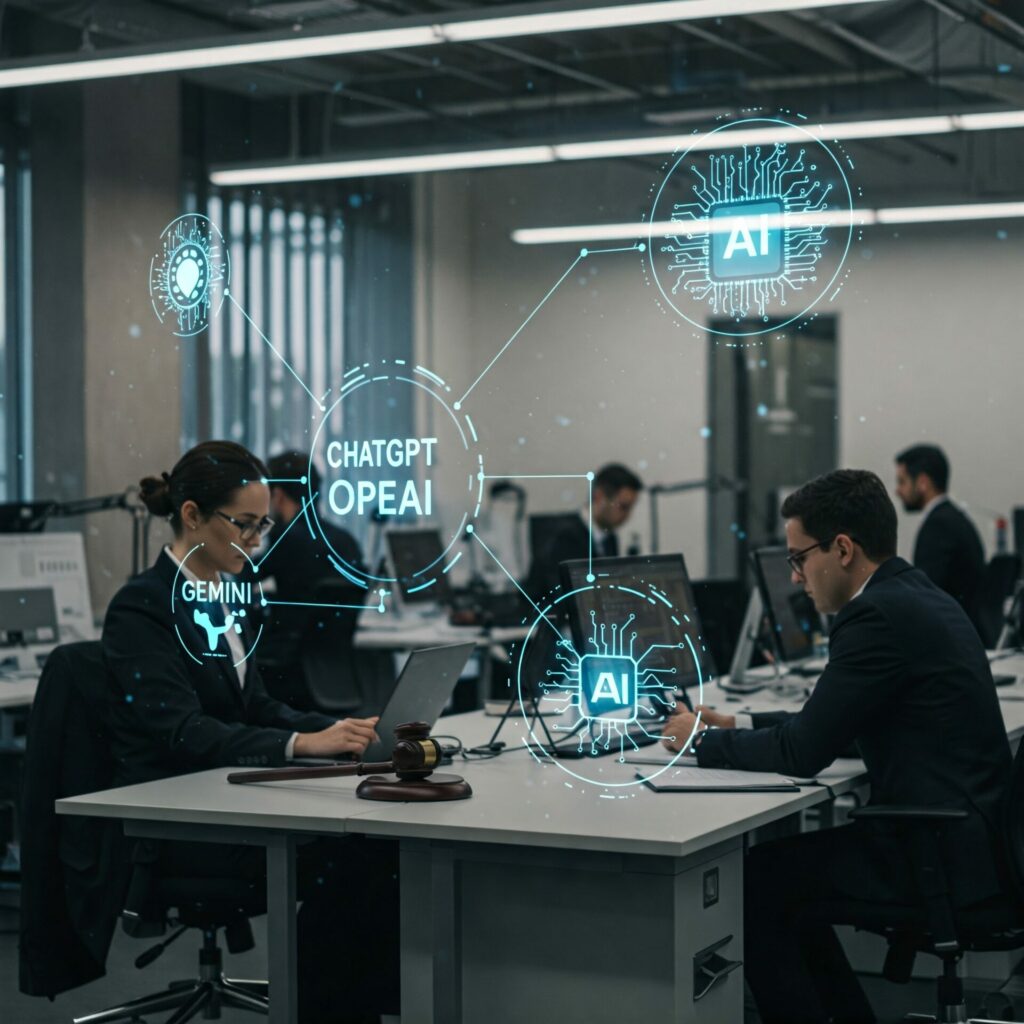The legal profession in 2025 stands at a fascinating crossroads, shaped profoundly by two powerful and increasingly intertwined forces: the relentless advancement of artificial intelligence (AI) and the ever-present and evolving threat of cybersecurity breaches. These aren’t merely technological trends; they are fundamental shifts that are reshaping how law firms operate, serve their clients, and navigate the complex legal landscape. This blog post will delve into the significant effects of AI adoption and the critical importance of robust cybersecurity in the legal sector. The Ascendant Role of Artificial Intelligence in Legal Practice The integration of AI into the legal profession has witnessed remarkable growth in recent years. According to the American Bar Association’s 2024 legal technology survey report, 30% of attorneys reported using AI tools in 2024, a significant jump from just 10% in 2021. This upward trajectory underscores a growing recognition of AI’s potential to transform various aspects of legal work. Several factors are fueling this surge in AI adoption. Daniel Linna, a senior lecturer at Northwestern University Pritzker School of Law, points to increased investment by law firms in AI-related initiatives, including training, policy development, change management, and the acquisition of AI tools or AI features within existing software like legal research platforms with generative AI capabilities. This proactive approach suggests a strategic shift towards leveraging AI to enhance efficiency and service delivery. While AI adoption is prevalent across firms of all sizes, larger firms with 100 or more attorneys have seen the most significant increase in AI usage, rising from 16% in 2023 to 46% in 2024. This disparity could be attributed to the greater financial resources these firms possess, allowing for more substantial investments in AI infrastructure and personnel. The most popular AI tool among lawyers is currently OpenAI’s conversational bot ChatGPT, with half of attorneys either using it or considering its use. This highlights the appeal of generative AI for tasks such as drafting initial documents, brainstorming arguments, and summarizing information. Harvard Law School’s Professor David Wilkins notes that even non-specialized AI like ChatGPT can produce a memo on a legal question “approximately as good as what a first-year law firm associate would produce”, albeit with the crucial caveat that lawyer review remains essential. As AI technology continues to improve and become more specialized for legal materials, its utility and potential for augmenting legal work will only increase. The potential applications of AI in law are vast. It can free up associate time spent on reviewing documents for more substantive work and help paralegals devote less time to manually preparing exhibits. AI-enabled case management solutions can increase reliability and decrease the chance of details falling through the cracks. This automation potential is significant, with one analysis suggesting that nearly three-quarters (74%) of a law firm’s hourly billable tasks are potentially exposed to automation by AI. Tasks like document review (98% automation potential), preparing legal documents (96%), and legal research (81%) show particularly high potential for AI augmentation. However, the integration of AI is not without its challenges. High-profile incidents where AI has generated non-existent case citations serve as stark reminders of the need for careful oversight and human verification. The technology is still evolving, and the phenomenon of AI “hallucinating” inaccurate information remains a concern. Moreover, there are worries about the potential for AI to exacerbate existing inequalities in access to justice if sophisticated tools are primarily available to well-resourced parties. Feargus MacDaeid, Co-Founder and Chief Strategy Officer at Definely, cautions against prioritizing speed over expertise in legal AI adoption. While AI excels at rapidly processing information (System 1 thinking), legal work often requires slow, critical thinking and emotional intelligence (System 2 thinking). He emphasizes that one AI system cannot do it all, and the future lies in domain-specific solutions integrated with human expertise. The Persistent Threat Landscape: Cybersecurity for Law Firms As law firms increasingly embrace digital technologies, including AI and cloud computing, they become more attractive targets for cyberattacks. The legal profession handles vast amounts of sensitive client data, making them a high-value target for malicious actors. According to a Bloomberg Law survey, 54% of law firm respondents cited security concerns as a barrier to tech adoption. Maintaining client trust and complying with stringent regulations necessitates a strong commitment to cybersecurity. The ABA survey reveals a growing trend of attorneys using cloud computing for work-related tasks, increasing from 60% in 2021 to 75% in 2024. While cloud services offer numerous benefits, they also introduce new security considerations and the need for robust data protection measures. Interestingly, the survey also indicates that data breaches are decreasing among larger law firms. Frank Gillman of Vertex Advisors Group attributes this to the fact that firms with over 100 attorneys are more likely to have the financial resources to invest in dedicated IT and cybersecurity teams, enabling them to deploy enterprise-grade security tools and establish formalized IT governance structures. This highlights a potential disparity in cybersecurity preparedness based on firm size. Despite the decreasing breaches in larger firms, cybersecurity remains a critical concern for all legal practices. The leading types of security tools used by law firms include spam filters, firewall software, anti-spyware, and mandatory passwords. Furthermore, the adoption of cyber liability insurance is on the rise, increasing from 40% in 2023 to over half of respondents in 2024, indicating a growing awareness of the financial risks associated with cyber incidents. The Convergence of AI and Cybersecurity Risks The integration of AI into legal workflows introduces a new layer of complexity to the cybersecurity landscape. Generative AI, with its ability to create realistic text and voice imitations, presents opportunities for misuse, including the creation of convincing phishing attacks or the manipulation of evidence. The vast datasets used to train AI models often contain sensitive information, raising concerns about data privacy and the potential for inference attacks that could reveal anonymized personal data. AI platforms can also inadvertently reinforce and perpetuate historical human biases, compromise data security, and produce misinformation. Therefore, a holistic approach to security in the age of AI requires not only protecting against traditional cyber threats but also addressing the unique risks introduced by AI technologies themselves. This includes implementing robust and clear governance and risk management structures and protocols for AI technologies, as well as establishing accountability mechanisms. Navigating the Regulatory Maze The legal and regulatory landscape surrounding both AI and cybersecurity is rapidly evolving. Globally, legislators and regulators are grappling with how to maximize the benefits of AI while mitigating its risks. The EU AI Act is a prominent example of comprehensive legislation aiming to categorize AI systems based on risk levels and impose corresponding requirements. While the US is not expected to pass federal AI legislation imminently, regulators like the Federal Trade Commission (FTC) are actively investigating AI platforms in response to public concerns. A common approach to AI regulation is a risk-based framework, where regulations are tailored to the perceived risks to core values like privacy, non-discrimination, transparency, and security. Many jurisdictions are also pursuing sector-specific rules in addition to sector-agnostic regulations due to the diverse applications of AI. Furthermore, AI-related rulemaking is often considered within the context of other digital policy priorities, such as cybersecurity and data privacy. For law firms, staying ahead of this evolving regulatory landscape is crucial. They need to understand the AI regulations in effect within their operating markets and align their internal AI policies accordingly. Engaging in dialogue with public sector officials can also help firms better understand regulatory trends and provide valuable insights to policymakers. In the realm of cybersecurity, existing legal and ethical obligations already mandate the protection of client data. However, the integration of AI may necessitate a re-evaluation of these frameworks to address new vulnerabilities and ensure compliance in an AI-driven environment. Preparing Law Firms for the Future: A Proactive Approach To thrive in this era of technological transformation, law firms must adopt a proactive and integrated approach to both AI and cybersecurity. This includes: Conclusion The convergence of artificial intelligence and the imperative for robust cybersecurity presents both transformative opportunities and significant challenges for the legal profession. AI offers the potential to enhance efficiency, improve client service, and unlock new insights from legal data. However, this progress must be underpinned by a strong commitment to cybersecurity to protect sensitive client information and maintain the integrity of legal processes. Law firms that strategically integrate AI while prioritizing security, staying informed on regulatory developments, and fostering a culture of vigilance will be best positioned to navigate the evolving legal landscape and thrive in the years to come. References: “5 takeaways from the ABA legal tech survey.pdf” “Accountability of AI Under the Law: The Role of Explanation – Scholars at Harvard” https://dash.harvard.edu/entities/publication/73120379-2f8b-6bd4-e053-0100007fdf3b “Artificial Intelligence regulation, global trends | EY – US” https://www.ey.com/en_us/services/ai “Cybersecurity Trends and Preparation for Law Firms in 2025” https://blog.protexurelawyers.com/cybersecurity-tactics-for-law-firms-1 “Global AI Law and Policy Tracker – IAPP” https://iapp.org/resources/article/global-ai-legislation-tracker “Harvard Law expert explains how AI may transform the legal profession in 2024” “How to Secure Your 2025 Legal Tech.pdf” “The Implications of AI for Criminal Justice” https://counciloncj.org/the-implications-of-ai-for-criminal-justice/ “When Legal Tech Comes of Age.pdf” 


Swift Chip provides managed IT and cybersecurity services for a wide variety of companies in fields with stringent privacy and compliance requirements.
11600 Washington Place - Suite 116 C, Los Angeles, CA 90066
[email protected] 310-881-8770